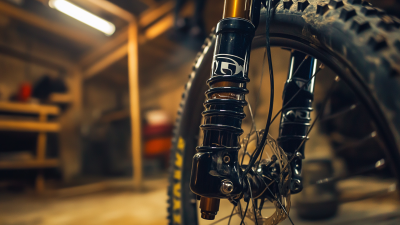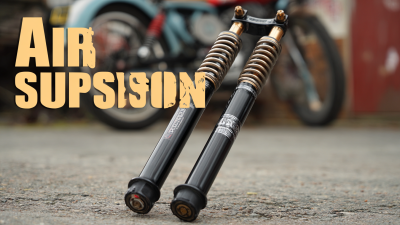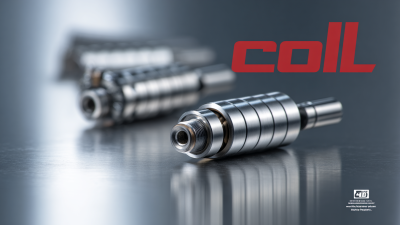In the realm of mountain biking, the quest for a smoother ride has led to significant advancements in bike technology, particularly in the development of the Air Suspension Fork. According to a report by the Bike Components Association, bikes equipped with air suspension systems can reduce the impact of rugged terrains by up to 30%, compared to traditional coil spring forks. This innovative technology utilizes air pressure to provide adjustable suspension, which allows riders to customize their setup based on weight and riding conditions. Additionally, a study by the Mountain Bike Research Institute noted that bikes with air suspension forks significantly enhance rider control and comfort, leading to improved performance and reduced fatigue during long rides. As more cyclists seek enhanced ride experiences, understanding the benefits of Air Suspension Forks becomes essential for both casual and competitive bikers looking to tackle varied landscapes with confidence.

Air suspension forks have revolutionized the mountain biking experience, providing significant advantages in both comfort and performance. Research highlights that riders equipped with air suspension forks can experience up to 20% improved shock absorption compared to traditional coil forks, allowing for a smoother ride over rugged terrains. This enhanced performance not only reduces rider fatigue but also improves control, especially on steep descents and technical trails.
Furthermore, the adjustability of air suspension forks allows riders to fine-tune the pressure according to their weight and riding style. According to a study by the International Mountain Bicycling Association, over 75% of riders reported a noticeable increase in handling and stability when using air suspension. The ability to customize settings means that riders can optimize their setup for different conditions, resulting in a more enjoyable and efficient ride. As a result, air suspension forks represent a significant advancement in mountain biking technology, enhancing both comfort and overall performance on the trails.
When comparing air suspension to coil suspension in mountain biking, one must consider the distinct advantages each system offers. Air suspension forks typically provide a lighter weight and a greater ability to fine-tune the ride characteristics, making them highly versatile for various trail conditions. Riders can adjust the air pressure to cater to their weight and riding style, leading to personalized performance on the trails. This adjustability allows for optimal performance in diverse terrain, providing enhanced traction and control during climbs and descents.
In contrast, coil suspension is often praised for its consistency and durability. While it may be heavier and offer less adjustability, coil systems excel in providing a plush feel on rough terrain, which can be particularly advantageous in aggressive downhill scenarios. Some riders prefer the predictable compression characteristics of coils, especially on longer rides where fatigue can influence performance. Ultimately, the choice between air and coil suspension boils down to personal preference and riding style, with each type offering unique benefits tailored to different aspects of mountain biking adventures.
Air suspension forks are a game-changer for mountain bikers seeking improved ride quality and handling. One of the key technical specifications to consider is the air pressure adjustment. Riders can customize the firmness of their forks by adjusting air pressure, allowing for tailored support based on the terrain and riding style. This adaptability is crucial for tackling varied conditions from steep descents to rugged trails, ensuring optimal performance.
Another important specification is the travel distance, which refers to how much the fork can compress. Longer travel distances provide more cushioning for larger impacts, making them ideal for aggressive downhill routes. Conversely, shorter travel forks may be more suitable for cross-country riding, where efficiency and quick responses are essential. Additionally, the weight of air suspension forks is typically lighter than their coil counterparts, enhancing the overall agility and maneuverability of the bike. Understanding these specifications helps riders make informed choices, leading to a more enjoyable and controlled riding experience.
 Air suspension forks have gained notable attention in the mountain biking community for their ability to enhance ride quality on challenging terrains. By employing air pressure to adjust the suspension's stiffness, these forks offer a customizable experience that caters to a rider's weight and riding style. Real-world performance data showcases that riders equipped with air suspension forks report significantly reduced fatigue and improved control, especially on rocky or uneven surfaces.
Air suspension forks have gained notable attention in the mountain biking community for their ability to enhance ride quality on challenging terrains. By employing air pressure to adjust the suspension's stiffness, these forks offer a customizable experience that caters to a rider's weight and riding style. Real-world performance data showcases that riders equipped with air suspension forks report significantly reduced fatigue and improved control, especially on rocky or uneven surfaces.
In testing scenarios, such as downhill trails or steep drops, the ability of air suspension to absorb shocks and maintain tire contact with the ground translates directly into better handling and rider confidence.
Moreover, the performance benefits of air suspension extend beyond just shock absorption. Riders have found that the increased adjustability allows for quick alterations to the fork's settings based on trail conditions. Data analysis from various mountain biking events suggests that riders who utilize air suspension can achieve faster times on technical courses, as they are able to better navigate obstacles and maintain speed without sacrificing comfort. The versatility of air suspension forks makes them an appealing choice for both recreational and competitive mountain bikers looking to elevate their performance on rough terrain.
 Air suspension forks are an excellent investment for mountain bikers looking to enhance their riding experience. However, to ensure their longevity and optimal functionality, regular maintenance is essential. First and foremost, keeping the fork clean is crucial. After each ride, wipe down the stanchions and remove any dirt or debris that may cause wear over time. Regularly inspect the seals for any signs of damage or leakage, as compromised seals can lead to performance issues and costly repairs.
Air suspension forks are an excellent investment for mountain bikers looking to enhance their riding experience. However, to ensure their longevity and optimal functionality, regular maintenance is essential. First and foremost, keeping the fork clean is crucial. After each ride, wipe down the stanchions and remove any dirt or debris that may cause wear over time. Regularly inspect the seals for any signs of damage or leakage, as compromised seals can lead to performance issues and costly repairs.
Another vital maintenance tip involves monitoring and adjusting the air pressure according to rider weight and terrain conditions. Over time, air pressure can fluctuate, affecting the fork’s responsiveness and performance. Utilize a shock pump to fine-tune the pressure, ensuring it’s at the recommended level for your riding style. Additionally, consider a routine service of the fork every 50 to 100 hours of riding, which typically includes replacing the oil and seals. This proactive approach not only extends the lifespan of the suspension fork but also guarantees a smoother and more enjoyable ride.






